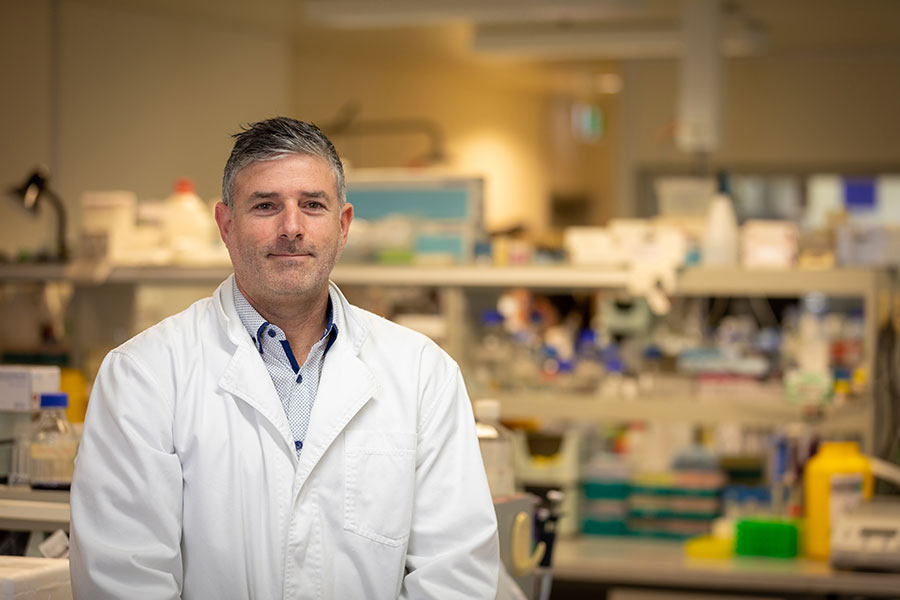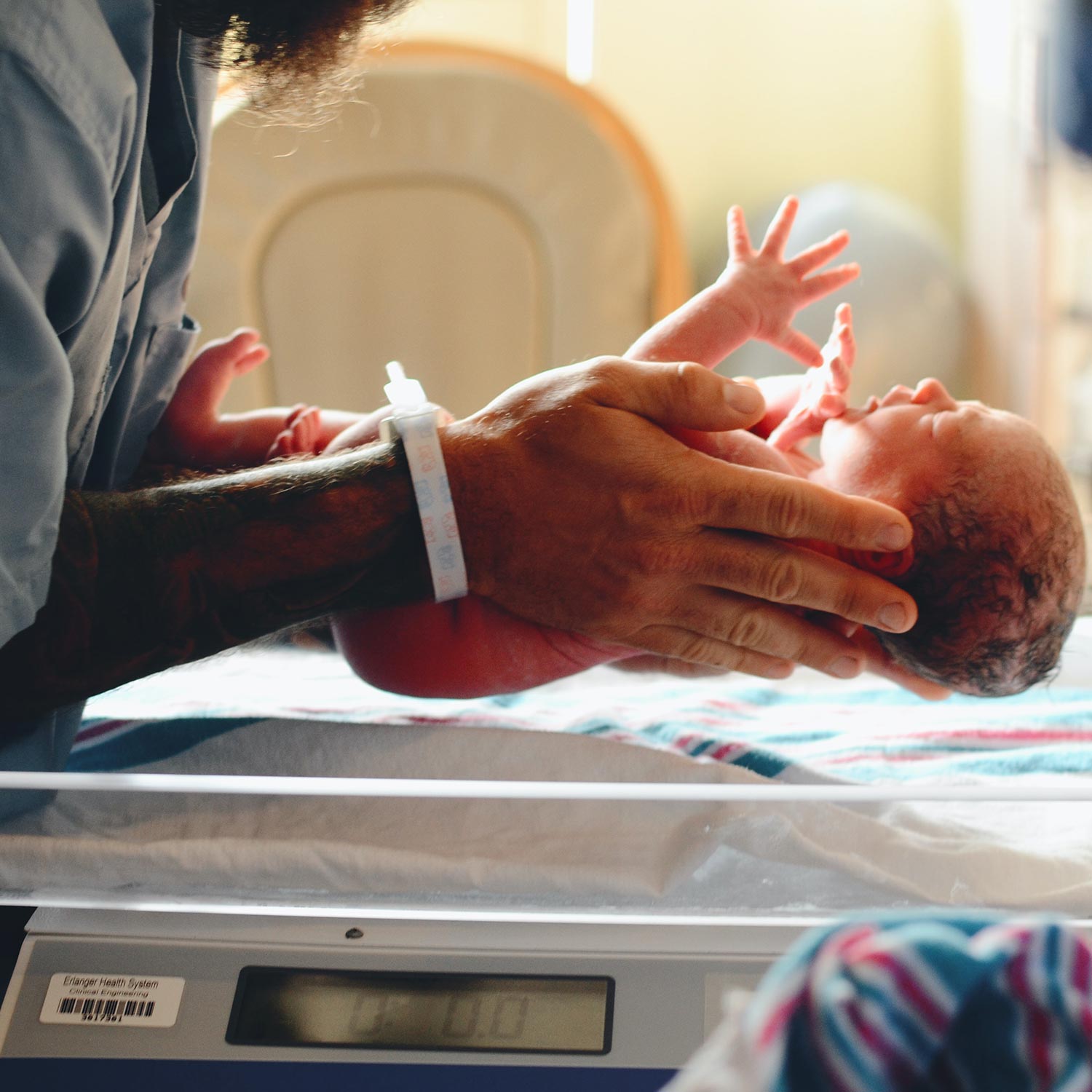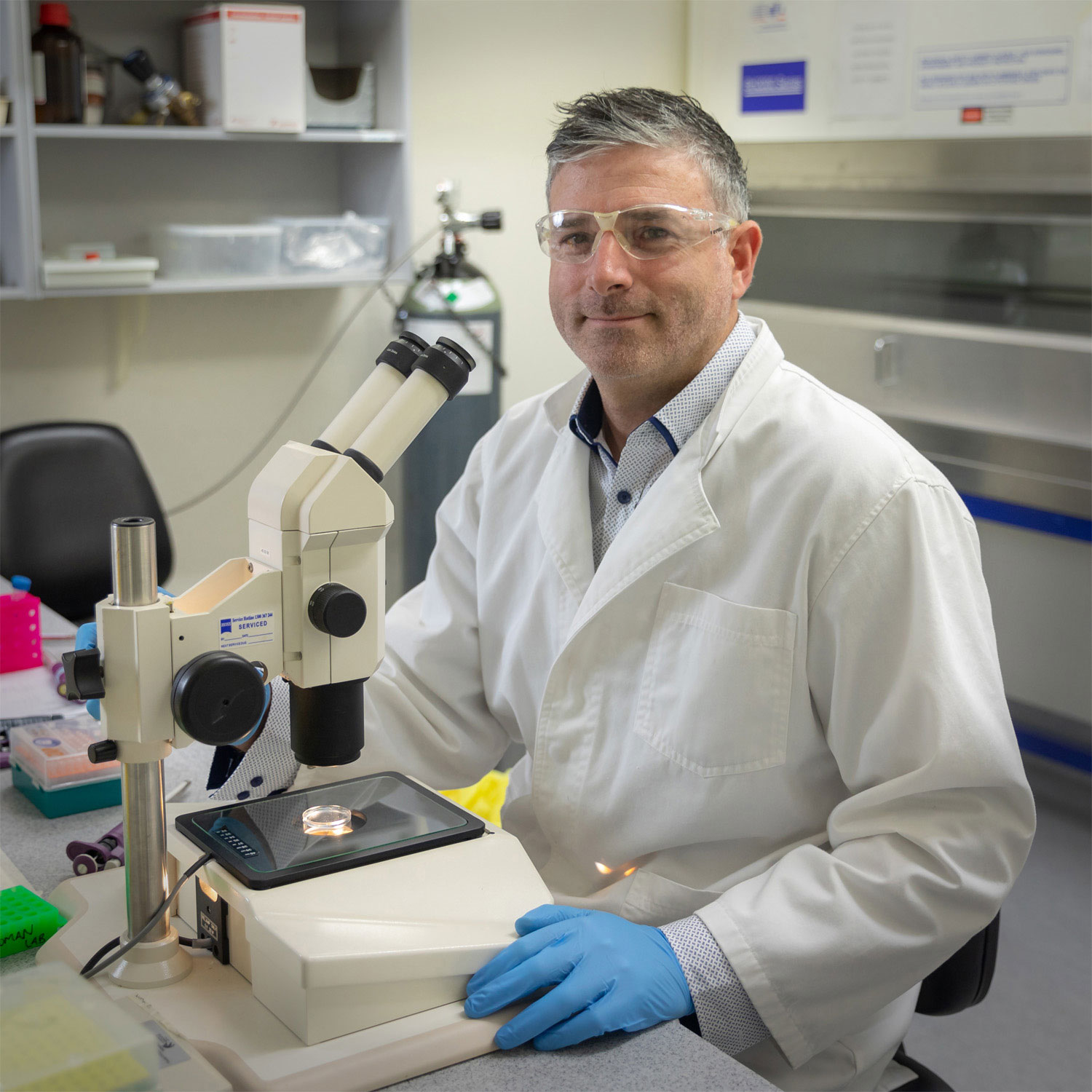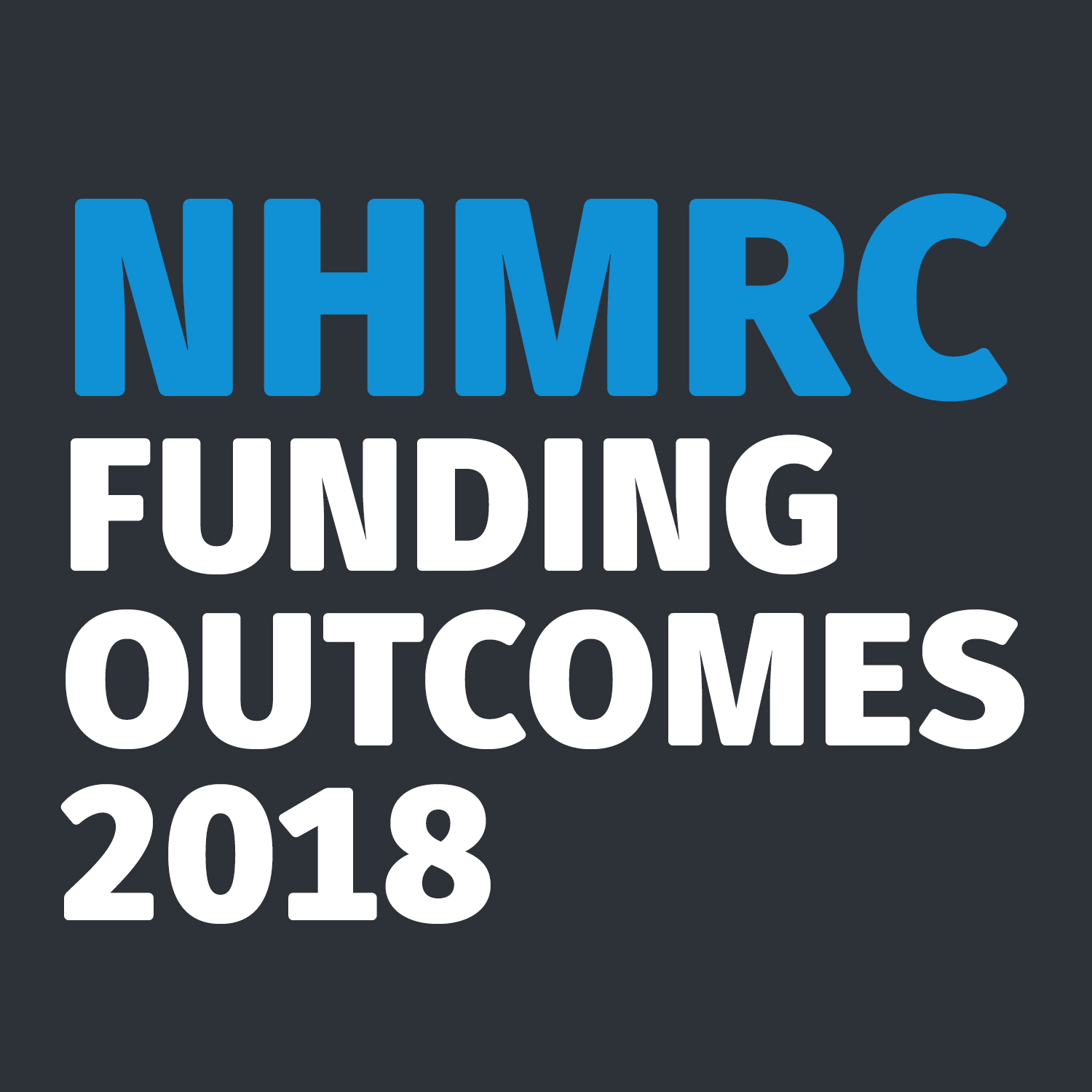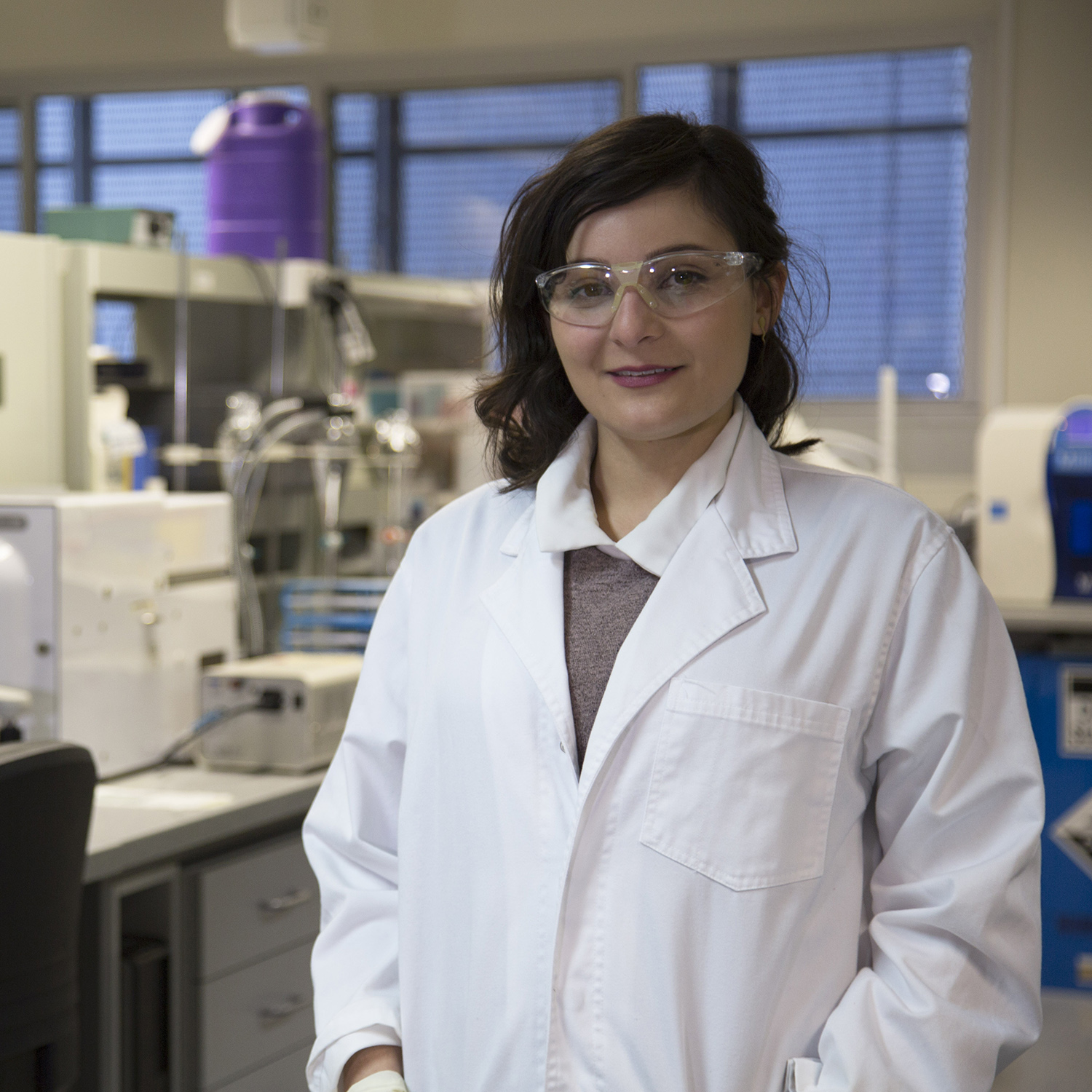| 2024 |
Calvert L, Martin JH, Anderson AL, Bernstein IR, Burke ND, De Iuliis GN, et al., 'Assessment of the impact of direct in vitro PFAS treatment on mouse spermatozoa.', Reprod Fertil, 5 (2024) [C1]
|
|
Nova |
| 2023 |
Fraser BA, Wilkins AL, De Iuliis GN, Rebourcet D, Nixon B, Aitken RJ, 'Development of a model for studying the developmental consequences of oxidative sperm DNA damage by targeting redox-cycling naphthoquinones to the Sertoli cell population.', Free radical biology & medicine, 206 50-62 (2023) [C1]
|
|
Nova |
| 2023 |
Nixon B, Schjenken JE, Burke ND, Skerrett-Byrne DA, Hart HM, De Iuliis GN, et al., 'New horizons in human sperm selection for assisted reproduction', Frontiers in Endocrinology, 14 (2023) [C1]
Male infertility is a commonly encountered pathology that is estimated to be a contributory factor in approximately 50% of couples seeking recourse to assisted reproductive techno... [more] Male infertility is a commonly encountered pathology that is estimated to be a contributory factor in approximately 50% of couples seeking recourse to assisted reproductive technologies. Upon clinical presentation, such males are commonly subjected to conventional diagnostic andrological practices that rely on descriptive criteria to define their fertility based on the number of morphologically normal, motile spermatozoa encountered within their ejaculate. Despite the virtual ubiquitous adoption of such diagnostic practices, they are not without their limitations and accordingly, there is now increasing awareness of the importance of assessing sperm quality in order to more accurately predict a male¿s fertility status. This realization raises the important question of which characteristics signify a high-quality, fertilization competent sperm cell. In this review, we reflect on recent advances in our mechanistic understanding of sperm biology and function, which are contributing to a growing armory of innovative approaches to diagnose and treat male infertility. In particular we review progress toward the implementation of precision medicine; the robust clinical adoption of which in the setting of fertility, currently lags well behind that of other fields of medicine. Despite this, research shows that the application of advanced technology platforms such as whole exome sequencing and proteomic analyses hold considerable promise in optimizing outcomes for the management of male infertility by uncovering and expanding our inventory of candidate infertility biomarkers, as well as those associated with recurrent pregnancy loss. Similarly, the development of advanced imaging technologies in tandem with machine learning artificial intelligence are poised to disrupt the fertility care paradigm by advancing our understanding of the molecular and biological causes of infertility to provide novel avenues for future diagnostics and treatments.
|
|
Nova |
| 2023 |
Germon ZP, Sillar JR, Mannan A, Duchatel RJ, Staudt D, Murray HC, et al., 'Blockade of ROS production inhibits oncogenic signaling in acute myeloid leukemia and amplifies response to precision therapies.', Sci Signal, 16 eabp9586 (2023) [C1]
|
|
Nova |
| 2022 |
Findlay IJ, De Iuliis GN, Duchatel RJ, Jackson ER, Vitanza NA, Cain JE, et al., 'Pharmaco-proteogenomic profiling of pediatric diffuse midline glioma to inform future treatment strategies', Oncogene, 41 461-475 (2022) [C1]
Diffuse midline glioma (DMG) is a deadly pediatric and adolescent central nervous system (CNS) tumor localized along the midline structures of the brain atop the spinal cord. With... [more] Diffuse midline glioma (DMG) is a deadly pediatric and adolescent central nervous system (CNS) tumor localized along the midline structures of the brain atop the spinal cord. With a median overall survival (OS) of just 9¿11-months, DMG is characterized by global hypomethylation of histone H3 at lysine 27 (H3K27me3), driven by recurring somatic mutations in H3 genes including, HIST1H3B/C (H3.1K27M) or H3F3A (H3.3K27M), or through overexpression of EZHIP in patients harboring wildtype H3. The recent World Health Organization¿s 5th Classification of CNS Tumors now designates DMG as, ¿H3 K27-altered¿, suggesting that global H3K27me3 hypomethylation is a ubiquitous feature of DMG and drives devastating transcriptional programs for which there are no treatments. H3-alterations co-segregate with various other somatic driver mutations, highlighting the high-level of intertumoral heterogeneity of DMG. Furthermore, DMG is also characterized by very high-level intratumoral diversity with tumors harboring multiple subclones within each primary tumor. Each subclone contains their own combinations of driver and passenger lesions that continually evolve, making precision-based medicine challenging to successful execute. Whilst the intertumoral heterogeneity of DMG has been extensively investigated, this is yet to translate to an increase in patient survival. Conversely, our understanding of the non-genomic factors that drive the rapid growth and fatal nature of DMG, including endogenous and exogenous microenvironmental influences, neurological cues, and the posttranscriptional and posttranslational architecture of DMG remains enigmatic or at best, immature. However, these factors are likely to play a significant role in the complex biological sequelae that drives the disease. Here we summarize the heterogeneity of DMG and emphasize how analysis of the posttranslational architecture may improve treatment paradigms. We describe factors that contribute to treatment response and disease progression, as well as highlight the potential for pharmaco-proteogenomics (i.e., the integration of genomics, proteomics and pharmacology) in the management of this uniformly fatal cancer.
|
|
Nova |
| 2022 |
Przystal JM, Cosentino CC, Yadavilli S, Zhang J, Laternser S, Bonner ER, et al., 'Imipridones affect tumor bioenergetics and promote cell lineage differentiation in diffuse midline gliomas', Neuro-Oncology, 24 1438-1451 (2022) [C1]
|
|
Nova |
| 2022 |
Calvert L, Green MP, De Iuliis GN, Dun MD, Turner BD, Clarke BO, et al., 'Assessment of the Emerging Threat Posed by Perfluoroalkyl and Polyfluoroalkyl Substances to Male Reproduction in Humans', FRONTIERS IN ENDOCRINOLOGY, 12 (2022) [C1]
|
|
Nova |
| 2022 |
Trigg NA, Skerrett-Byrne DA, Martin JH, De Iuliis GN, Dun MD, Roman SD, et al., 'Quantitative proteomic dataset of mouse caput epididymal epithelial cells exposed to acrylamide in vivo', DATA IN BRIEF, 42 (2022)
|
|
|
| 2022 |
Reinhardt LS, Zhang X, Groen K, Morten BC, De Iuliis GN, Braithwaite AW, et al., 'Alterations in the p53 isoform ratio govern breast cancer cell fate in response to DNA damage', CELL DEATH & DISEASE, 13 (2022) [C1]
|
|
Nova |
| 2021 |
Medica AJ, Aitken RJ, Nicolson GL, Sheridan AR, Swegen A, Iuliis GND, Gibb Z, 'Glycerophospholipids protect stallion spermatozoa from oxidative damage in vitro', Reproduction and Fertility, 2 199-209 (2021) [C1]
|
|
Nova |
| 2021 |
Nixon B, Anderson AL, Bromfield EG, Martin JH, Cafe SL, Skerrett-Byrne DA, et al., 'Post-testicular sperm maturation in the saltwater crocodile Crocodylus porosus: assessing the temporal acquisition of sperm motility', REPRODUCTION FERTILITY AND DEVELOPMENT, 33 530-539 (2021) [C1]
|
|
Nova |
| 2021 |
Skerrett-Byrne DA, Anderson AL, Hulse L, Wass C, Dun MD, Bromfield EG, et al., 'Proteomic analysis of koala (phascolarctos cinereus) spermatozoa and prostatic bodies', Proteomics, 21 (2021) [C1]
The aims of this study were to investigate the proteome of koala spermatozoa and that of the prostatic bodies with which they interact during ejaculation. For this purpose, sperma... [more] The aims of this study were to investigate the proteome of koala spermatozoa and that of the prostatic bodies with which they interact during ejaculation. For this purpose, spermatozoa and prostatic bodies were fractionated from the semen of four male koalas and analysed by HPLC MS/MS. This strategy identified 744 sperm and 1297 prostatic body proteins, which were subsequently attributed to 482 and 776 unique gene products, respectively. Gene ontology curation of the sperm proteome revealed an abundance of proteins mapping to the canonical sirtuin and 14-3-3 signalling pathways. By contrast, protein ubiquitination and unfolded protein response pathways dominated the equivalent analysis of proteins uniquely identified in prostatic bodies. Koala sperm proteins featured an enrichment of those mapping to the functional categories of cellular compromise/inflammatory response, whilst those of the prostatic body revealed an over-representation of molecular chaperone and stress-related proteins. Cross-species comparisons demonstrated that the koala sperm proteome displays greater conservation with that of eutherians (human; 93%) as opposed to reptile (crocodile; 39%) and avian (rooster; 27%) spermatozoa. Together, this work contributes to our overall understanding of the core sperm proteome and has identified biomarkers that may contribute to the exceptional longevity of koala spermatozoa during ex vivo storage.
|
|
Nova |
| 2021 |
Duchatel RJ, Mannan A, Woldu AS, Hawtrey T, Hindley PA, Douglas AM, et al., 'Preclinical and clinical evaluation of German-sourced ONC201 for the treatment of H3K27M-mutant diffuse intrinsic pontine glioma.', Neuro-oncology advances, 3 vdab169 (2021) [C1]
|
|
Nova |
| 2021 |
Walters JLH, Anderson AL, da Silva SJM, Aitken RJ, De Iuliis GN, Sutherland JM, et al., 'Mechanistic insight into the regulation of lipoxygenase-driven lipid peroxidation events in human spermatozoa and their impact on male fertility', Antioxidants, 10 1-19 (2021) [C1]
A prevalent cause of sperm dysfunction in male infertility patients is the overproduction of reactive oxygen species, an attendant increase in lipid peroxidation and the productio... [more] A prevalent cause of sperm dysfunction in male infertility patients is the overproduction of reactive oxygen species, an attendant increase in lipid peroxidation and the production of cyto-toxic reactive carbonyl species such as 4-hydroxynonenal. Our previous studies have implicated arachidonate 15-lipoxygenase (ALOX15) in the production of 4-hydroxynonenal in developing germ cells. Here, we have aimed to develop a further mechanistic understanding of the lipoxygen-ase-lipid peroxidation pathway in human spermatozoa. Through pharmacological inhibition studies, we identified a protective role for phospholipase enzymes in the liberation of peroxidised polyunsaturated fatty acids from the human sperm membrane. Our results also revealed that arachi-donic acid, linoleic acid and docosahexanoic acid are key polyunsaturated fatty acid substrates for ALOX15. Upon examination of ALOX15 in the spermatozoa of infertile patients compared to their normozoospermic counterparts, we observed significantly elevated levels of ALOX15 protein abundance in the infertile population and an increase in 4-hydroxynonenal adducts. Collectively, these data confirm the involvement of ALOX15 in the oxidative stress cascade of human spermatozoa and support the notion that increased ALOX15 abundance in sperm cells may accentuate membrane lipid peroxidation and cellular dysfunction, ultimately contributing to male infertility.
|
|
Nova |
| 2021 |
Trigg NA, Skerrett-Byrne DA, Xavier MJ, Zhou W, Anderson AL, Stanger SJ, et al., 'Acrylamide modulates the mouse epididymal proteome to drive alterations in the sperm small non-coding RNA profile and dysregulate embryo development', Cell Reports, 37 (2021) [C1]
Paternal exposure to environmental stressors elicits distinct changes to the sperm sncRNA profile, modifications that have significant post-fertilization consequences. Despite thi... [more] Paternal exposure to environmental stressors elicits distinct changes to the sperm sncRNA profile, modifications that have significant post-fertilization consequences. Despite this knowledge, there remains limited mechanistic understanding of how paternal exposures modify the sperm sncRNA landscape. Here, we report the acute sensitivity of the sperm sncRNA profile to the reproductive toxicant acrylamide. Furthermore, we trace the differential accumulation of acrylamide-responsive sncRNAs to coincide with sperm transit of the proximal (caput) segment of the epididymis, wherein acrylamide exposure alters the abundance of several transcription factors implicated in the expression of acrylamide-sensitive sncRNAs. We also identify extracellular vesicles secreted from the caput epithelium in relaying altered sncRNA profiles to maturing spermatozoa and dysregulated gene expression during early embryonic development following fertilization by acrylamide-exposed spermatozoa. These data provide mechanistic links to account for how environmental insults can alter the sperm epigenome and compromise the transcriptomic profile of early embryos.
|
|
Nova |
| 2021 |
Nixon B, Anderson AL, Bromfield EG, Martin JH, Lord T, Cafe SL, et al., 'Gross and microanatomy of the male reproductive duct system of the saltwater crocodile Crocodylus porosus', REPRODUCTION FERTILITY AND DEVELOPMENT, 33 540-554 (2021) [C1]
|
|
Nova |
| 2021 |
Trigg NA, Stanger SJ, Zhou W, Skerrett-Byrne DA, Sipilä P, Dun MD, et al., 'A novel role for milk fat globule-EGF factor 8 protein (MFGE8) in the mediation of mouse sperm extracellular vesicle interactions', Proteomics, 21 (2021) [C1]
Spermatozoa transition to functional maturity as they are conveyed through the epididymis, a highly specialized region of the male excurrent duct system. Owing to their transcript... [more] Spermatozoa transition to functional maturity as they are conveyed through the epididymis, a highly specialized region of the male excurrent duct system. Owing to their transcriptionally and translationally inert state, this transformation into fertilization competent cells is driven by complex mechanisms of intercellular communication with the secretory epithelium that delineates the epididymal tubule. Chief among these mechanisms are the release of extracellular vesicles (EV), which have been implicated in the exchange of varied macromolecular cargo with spermatozoa. Here, we describe the optimization of a tractable cell culture model to study the mechanistic basis of sperm¿extracellular vesicle interactions. In tandem with receptor inhibition strategies, our data demonstrate the importance of milk fat globule-EGF factor 8 (MFGE8) protein in mediating the efficient exchange of macromolecular EV cargo with mouse spermatozoa; with the MFGE8 integrin-binding Arg-Gly-Asp (RGD) tripeptide motif identified as being of particular importance. Specifically, complementary strategies involving MFGE8 RGD domain ablation, competitive RGD-peptide inhibition and antibody-masking of alpha V integrin receptors, all significantly inhibited the uptake and redistribution of EV-delivered proteins into immature mouse spermatozoa. These collective data implicate the MFGE8 ligand and its cognate integrin receptor in the mediation of the EV interactions that underpin sperm maturation.
|
|
Nova |
| 2020 |
Nixon B, Cafe SL, Eamens AL, De Iuliis GN, Bromfield EG, Martin JH, et al., 'Molecular insights into the divergence and diversity of post-testicular maturation strategies', Molecular and Cellular Endocrinology, 517 110955-110955 (2020) [C1]
|
|
Nova |
| 2020 |
Gilbert J, De Iuliis GN, McCluskey A, Sakoff JA, 'A novel naphthalimide that selectively targets breast cancer via the arylhydrocarbon receptor pathway', Scientific Reports, 10 (2020) [C1]
|
|
Nova |
| 2020 |
Gibb Z, Griffin RA, Aitken RJ, De Iuliis GN, 'Functions and effects of reactive oxygen species in male fertility', Animal Reproduction Science, 220 (2020) [C1]
Reactive oxygen species (ROS) are implicated in all aspects of cellular functions. While the importance of ROS as signalling molecules is well described, ROS are also associated w... [more] Reactive oxygen species (ROS) are implicated in all aspects of cellular functions. While the importance of ROS as signalling molecules is well described, ROS are also associated with stress pathologies. Within the reproduction field, there are associations with reduced fertility as a result of lipid peroxidation, protein dysfunction, premature cell death and DNA damage which readily occur in spermatozoa. These oxidative insults can arise in vivo, or in vitro as a result of sperm storage, purification and processing. Following a brief description of the production, homeostasis and functions of ROS in mammalian sperm function, this review paper will focus on describing the predominant sources of ROS in the ejaculate, the effects of ROS on a cellular and molecular level, and the actions of ROS from the whole animal perspective. There is highlighting of some studies, which have revealed the mechanisms for these observations, along with some strategies to ameliorate or prevent the instigation of the oxidative stress cascade before irreversible damage to spermatozoa occurs.
|
|
Nova |
| 2020 |
Steffens Reinhardt L, Zhang X, Wawruszak A, Groen K, De Iuliis GN, Avery-Kiejda KA, 'Good Cop, Bad Cop: Defining the Roles of 40p53 in Cancer and Aging', Cancers, 12 (2020) [C1]
|
|
Nova |
| 2020 |
Aitken RJ, De Iuliis GN, Nixon B, 'The Sins of Our Forefathers: Paternal Impacts on De Novo Mutation Rate and Development', Annual Review of Genetics, 54 1-24 (2020) [C1]
|
|
Nova |
| 2020 |
Dun MD, Mannan A, Rigby CJ, Butler S, Toop HD, Beck D, et al., 'Shwachman Bodian Diamond syndrome (SBDS) protein is a direct inhibitor of protein phosphatase 2A (PP2A) activity and overexpressed in acute myeloid leukaemia', Leukemia, 34 3393-3397 (2020) [C1]
|
|
Nova |
| 2019 |
Sillar JR, Germon ZP, DeIuliis GN, Dun MD, 'The Role of Reactive Oxygen Species in Acute Myeloid Leukaemia.', International Journal of Molecular Sciences, 20 (2019) [C1]
|
|
Nova |
| 2019 |
Nixon B, De Iuliis GN, Dun MD, Zhou W, Trigg NA, Eamens AL, 'Profiling of epididymal small non-protein-coding RNAs', Andrology, 7 669-680 (2019) [C1]
|
|
Nova |
| 2019 |
Nixon B, De Iuliis GN, Hart HM, Zhou W, Mathe A, Bernstein IR, et al., 'Proteomic profiling of mouse epididymosomes reveals their contributions to post-testicular sperm maturation', Molecular and Cellular Proteomics, 18 S91-S108 (2019) [C1]
|
|
Nova |
| 2019 |
Houston BJ, Nixon B, McEwan KE, Martin J, King BV, Aitken RJ, De Iuliis GN, 'Whole-body exposures to radiofrequency-electromagnetic energy can cause DNA damage in mouse spermatozoa via an oxidative mechanism', Scientific Reports, 9 (2019) [C1]
|
|
Nova |
| 2019 |
Nixon B, Bernstein IR, Cafe SL, Delehedde M, Sergeant N, Anderson AL, et al., 'A Kinase Anchor Protein 4 is vulnerable to oxidative adduction in male germ cells', Frontiers in Cell and Developmental Biology, 7 (2019) [C1]
|
|
Nova |
| 2019 |
Zhou W, Stanger SJ, Anderson AL, Bernstein IR, De Iuliis GN, McCluskey A, et al., 'Mechanisms of tethering and cargo transfer during epididymosome-sperm interactions.', BMC biology, 17 35-35 (2019) [C1]
|
|
Nova |
| 2018 |
Zhou W, De Iuliis GN, Dun MD, Nixon B, 'Characteristics of the epididymal luminal environment responsible for sperm maturation and storage', Frontiers in Endocrinology, 9 (2018) [C1]
|
|
Nova |
| 2018 |
Gilbert J, De Iuliis GN, Tarleton M, McCluskey A, Sakoff JA, '(Z)-2-(3,4-dichlorophenyl)-3-(1H-pyrrol-2-yl)acrylonitrile exhibits selective antitumor activity in breast cancer cell lines via the aryl hydrocarbon receptor pathway', Molecular Pharmacology, 93 168-177 (2018) [C1]
|
|
Nova |
| 2018 |
Zhou W, Sipilä P, De Iuliis G, Dun MD, Nixon B, 'Analysis of Epididymal Protein Synthesis and Secretion', Jove-Journal of Visualized Experiments, 138 (2018) [C1]
|
|
Nova |
| 2018 |
Houston BJ, Nixon B, King BV, Aitken RJ, De Iuliis GN, 'Probing the Origins of 1,800 MHz Radio Frequency Electromagnetic Radiation Induced Damage in Mouse Immortalized Germ Cells and Spermatozoa in vitro', FRONTIERS IN PUBLIC HEALTH, 6 (2018) [C1]
|
|
Nova |
| 2018 |
Walters JLH, De Iuliis G, Nixon B, Bromfield EG, 'Oxidative Stress in the Male Germline: A Review of Novel Strategies to Reduce 4-Hydroxynonenal Production', Antioxidants, 7 (2018) [C1]
|
|
Nova |
| 2018 |
Walters JLH, De Iuliis GN, Dun MD, Aitken RJ, McLaughlin EA, Nixon B, Bromfield EG, 'Pharmacological inhibition of arachidonate 15-lipoxygenase protects human spermatozoa against oxidative stress.', Biology of reproduction, 98 784-794 (2018) [C1]
|
|
Nova |
| 2018 |
Mihalas BP, Bromfield EG, Sutherland JM, De Iuliis GN, McLaughlin EA, John Aitken R, Nixon B, 'Oxidative damage in naturally aged mouse oocytes is exacerbated by dysregulation of proteasomal activity', Journal of Biological Chemistry, 293 18944-18964 (2018) [C1]
|
|
Nova |
| 2018 |
Houston BJ, Nixon B, Martin JH, De Iuliis GN, Trigg NA, Bromfield EG, et al., 'Heat exposure induces oxidative stress and DNA damage in the male germ line', BIOLOGY OF REPRODUCTION, 98 593-606 (2018) [C1]
|
|
Nova |
| 2017 |
Zhou W, De Iuliis GN, Turner AP, Reid AT, Anderson AL, McCluskey A, et al., 'Developmental expression of the dynamin family of mechanoenzymes in the mouse epididymis', BIOLOGY OF REPRODUCTION, 96 159-173 (2017) [C1]
|
|
Nova |
| 2017 |
Mihalas BP, De Iuliis GN, Redgrove KA, McLaughlin EA, Nixon B, 'The lipid peroxidation product 4-hydroxynonenal contributes to oxidative stress-mediated deterioration of the ageing oocyte', SCIENTIFIC REPORTS, 7 (2017) [C1]
|
|
Nova |
| 2017 |
Zhou W, Anderson AL, Turner AP, De Iuliis GN, McCluskey A, McLaughlin EA, Nixon B, 'Characterization of a novel role for the dynamin mechanoenzymes in the regulation of human sperm acrosomal exocytosis.', Molecular Human Reproduction, 23 657-673 (2017) [C1]
|
|
Nova |
| 2016 |
Houston B, Nixon B, King BV, De Iuliis GN, Aitken RJ, 'The effects of radiofrequency electromagnetic radiation on sperm function', Reproduction, 152 R263-R276 (2016) [C1]
|
|
Nova |
| 2016 |
Aitken RJ, Muscio L, Whiting S, Connaughton HS, Fraser BA, Nixon B, et al., 'Analysis of the effects of polyphenols on human spermatozoa reveals unexpected impacts on mitochondrial membrane potential, oxidative stress and DNA integrity; implications for assisted reproductive technology', Biochemical Pharmacology, 121 78-96 (2016) [C1]
|
|
Nova |
| 2014 |
Aitken RJ, Finnie JM, Muscio L, Whiting S, Connaughton HS, Kuczera L, et al., 'Potential importance of transition metals in the induction of DNA damage by sperm preparation media', Human Reproduction, 29 2136-2147 (2014) [C1]
STUDY QUESTION: What are the mechanisms by which the preparation of spermatozoa on discontinuous density gradients leads to an increase in oxidative DNA damage? SUMMARY ANSWER: Th... [more] STUDY QUESTION: What are the mechanisms by which the preparation of spermatozoa on discontinuous density gradients leads to an increase in oxidative DNA damage? SUMMARY ANSWER: The colloidal silicon solutions that are commonly used to prepare human spermatozoa for assisted reproduction technology (ART) purposes contain metals in concentrations that promote free radical-mediated DNA damage. WHAT IS KNOWN ALREADY: Sporadic reports have already appeared indicating that the use of colloidal silicon-based discontinuous density gradients for sperm preparation is occasionally associated with the induction of oxidative DNA damage. The cause of this damage is however unknown. STUDY DESIGN, SIZE, DURATION: This study comprised a series of experiments designed to: (i) confirm the induction of oxidativeDNA damage in spermatozoa prepared on commercially available colloidal silicon gradients, (ii) compare the levels of damage observed with alterative sperm preparation techniques including an electrophoretic approach and (iii) determine the cause of the oxidative DNA damage and develop strategies for its prevention. The semen samples employed for this analysis involved a cohort of >50 unselected donors and at least three independent samples were used for each component of the analysis. PARTICIPANTS/MATERIALS, SETTING, METHODS: The setting was a University biomedical science laboratory. The major techniques employed were: (i) flow cytometry to study reactive oxygen species generation, lipid peroxidation and DNA damage, (ii) computeraided sperm analysis to measure spermmovement and (iii) inductively coupled mass spectrometry to determine the elemental composition of sperm preparation media. MAIN RESULTS AND THE ROLE OF CHANCE: Oxidative DNA damage is induced in spermatozoa prepared on PureSperm® discontinuous colloidal silicon gradients (P < 0.001 versus repeated centrifugation) because this medium contains metals, particularly Fe, Al and Cu, which are known to promote free radical generation in the immediate vicinity of DNA. This damage can be significantly accentuated by reducing agents, such as ascorbate (P < 0.001) and inhibited by selective chelation (P < 0.001). This problem is not confined to PureSperm®; analysis of additional commercial sperm preparation media revealed that metal contamination is a relatively constant feature of such products. LIMITATIONS, REASONS FOR CAUTION: While the presence of metals, particularly transition metals, may exacerbate the levels of oxidative DNA damage seen in human spermatozoa, the significance of such damage has not yet been tested in suitably powered clinical trials. WIDER IMPLICATIONS OF THE FINDINGS: The results explain why the preparation of spermatozoa on discontinuous colloidal silicon gradients can result in oxidative DNA damage. The results are of immediate relevance to the development of safe, effective protocols for the preparation of spermatozoa for ART purposes. STUDY FUNDING/COMPETING INTEREST(S): The studywas funded by the Australian Health and Medical ResearchCouncil. One of the authors (R.J.A.) has had a consultantship with a biotechnology company, NuSep, interested in the development of electrophoretic methods of sperm preparation. He has no current financial interest in this area. None of the other authors have a conflict of interest to declare.
|
|
Nova |
| 2014 |
Aitken RJ, Smith TB, Jobling MS, Baker MA, De Iuliis GN, 'Oxidative stress and male reproductive health', Asian Journal of Andrology, 16 31-38 (2014) [C1]
One of the major causes of defective sperm function is oxidative stress, which not only disrupts the integrity of sperm DNA but also limits the fertilizing potential of these cell... [more] One of the major causes of defective sperm function is oxidative stress, which not only disrupts the integrity of sperm DNA but also limits the fertilizing potential of these cells as a result of collateral damage to proteins and lipids in the sperm plasma membrane. The origins of such oxidative stress appear to involve the sperm mitochondria, which have a tendency to generate high levels of superoxide anion as a prelude to entering the intrinsic apoptotic cascade. Unfortunately, these cells have very little capacity to respond to such an attack because they only possess the first enzyme in the base excision repair (BER) pathway, 8-oxoguanine glycosylase 1 (OGG1). The latter successfully creates an abasic site, but the spermatozoa cannot process the oxidative lesion further because they lack the downstream proteins (APE1, XRCC1) needed to complete the repair process. It is the responsibility of the oocyte to continue the BER pathway prior to initiation of S-phase of the first mitotic division. If a mistake is made by the oocyte at this stage of development, a mutation will be created that will be represented in every cell in the body. Such mechanisms may explain the increase in childhood cancers and other diseases observed in the offspring of males who have suffered oxidative stress in their germ line as a consequence of age, environmental or lifestyle factors. The high prevalence of oxidative DNA damage in the spermatozoa of male infertility patients may have implications for the health of children conceivedin vitro and serves as a driver for current research into the origins of free radical generation in the germ line. © 2014 AJA, SIMM & SJTU. All rights reserved.
|
|
Nova |
| 2013 |
De Iuliis GN, Newey RJ, King BV, Aitken RJ, 'Correction: Mobile phone radiation induces reactive oxygen species production and DNA damage in human spermatozoa in vitro (PLoS ONE)', PLoS ONE, 8 (2013)
|
|
|
| 2013 |
Aitken RJ, Bronson R, Smith TB, De Iuliis GN, 'The source and significance of DNA damage in human spermatozoa; a commentary on diagnostic strategies and straw man fallacies', Molecular Human Reproduction, 19 475-485 (2013) [C1]
|
|
Nova |
| 2013 |
Smith TB, De Iuliis GN, Lord T, Aitken RJ, 'The senescence-accelerated mouse prone 8 as a model for oxidative stress and impaired DNA repair in the male germ line', Reproduction, 146 253-262 (2013) [C1]
|
|
Nova |
| 2013 |
Lewis SEM, Aitken RJ, Conner SJ, De Iuliis G, Evenson DP, Henkel R, et al., 'The impact of sperm DNA damage in assisted conception and beyond: Recent advances in diagnosis and treatment', Reproductive BioMedicine Online, 27 325-337 (2013) [C1]
|
|
Nova |
| 2013 |
Aitken RJ, Smith TB, Lord T, Kuczera L, Koppers AJ, Naumovski N, et al., 'On methods for the detection of reactive oxygen species generation by human spermatozoa: analysis of the cellular responses to catechol oestrogen, lipid aldehyde, menadione and arachidonic acid', Andrology, 1 192-205 (2013) [C1]
|
|
Nova |
| 2012 |
Aitken RJ, Gibb Z, Mitchell LA, Lambourne SR, Connaughton HS, De Iuliis GN, 'Sperm motility is lost in vitro as a consequence of mitochondrial free radical production and the generation of electrophilic aldehydes but can be significantly rescued by the presence of nucleophilic thiols', Biology of Reproduction, 87 1-11 (2012) [C1]
|
|
Nova |
| 2012 |
Aitken RJ, Whiting SJ, De Iuliis GN, McClymont SL, Mitchell LA, Baker MA, 'Electrophilic aldehydes generated by sperm metabolism activate mitochondrial reactive oxygen species generation and apoptosis by targeting succinate dehydrogenase', Journal of Biological Chemistry, 287 33048-33060 (2012) [C1]
|
|
Nova |
| 2012 |
Aitken RJ, De Iuliis GN, Gibb Z, Baker MA, 'The Simmet lecture: New horizons on an old landscape - oxidative stress, DNA damage and apoptosis in the male germ line', Reproduction in Domestic Animals, 47 7-14 (2012) [C2]
|
|
|
| 2011 |
Aitken RJ, Mitchell L, De Iuliis GN, 'Reply: M540 bodies interfere with TUNEL analyses in human semen samples', HUMAN REPRODUCTION, 26 729-730 (2011) [C3]
|
|
|
| 2010 |
Aitken RJ, De Iuliis GN, Finnie JM, Hedges A, McLachlan RI, 'Analysis of the relationships between oxidative stress, DNA damage and sperm vitality in a patient population: Development of diagnostic criteria', Human Reproduction, 25 2415-2426 (2010) [C1]
|
|
Nova |
| 2010 |
Mitchell LA, De Iuliis GN, Aitken RJ, 'The TUNEL assay consistently underestimates DNA damage in human spermatozoa and is influenced by DNA compaction and cell vitality: Development of an improved methodology', International Journal of Andrology, 34 2-13 (2010) [C1]
|
|
|
| 2010 |
Aitken RJ, De Iuliis GN, 'On the possible origins of DNA damage in human spermatozoa', Molecular Human Reproduction, 16 3-13 (2010) [C1]
|
|
Nova |
| 2009 |
De Iuliis GN, Newey RJ, King BV, Aitken RJ, 'Mobile phone radiation induces reactive oxygen species production and DNA damage in human spermatozoa in vitro', PLoS ONE, 4 e6446 (2009) [C1]
|
|
Nova |
| 2009 |
Bennetts LE, De Iuliis GN, Nixon B, Kime M, Zelski K, McVicar CM, et al., 'Impact of Estrogenic Compounds on DNA Integrity in Human Spermatozoa: Evidence for Cross-Linking and Redox Cycling Activities', JOURNAL OF UROLOGY, 181 914-915 (2009) [C1]
|
|
|
| 2009 |
De Iuliis GN, Thomson LK, Mitchell LA, Read JM, Koppers AJ, Hedges A, et al., 'DNA damage in human spermatozoa is highly correlated with the efficiency of chromatin remodeling and the formation of 8-hydroxy-2'-deoxyguanosine, a marker of oxidative stress', Biology of Reproduction, 81 517-524 (2009) [C1]
|
|
Nova |
| 2009 |
Czarny NA, Harris MS, De Iuliis GN, Rodger JC, 'Acrosomal integrity, viability, and DNA damage of sperm from dasyurid marsupials after freezing or freeze drying', Theriogenology, 72 817-825 (2009) [C1]
|
|
Nova |
| 2009 |
Aitken RJ, De Iuliis GN, McLachlan RI, 'Biological and clinical significance of DNA damage in the male germ line', International Journal of Andrology, 32 46-56 (2009) [C1]
|
|
Nova |
| 2009 |
Thomson LK, Fleming SD, Aitken RJ, De Iuliis GN, Zieschang JA, Clark AM, 'Cryopreservation-induced human sperm DNA damage is predominantly mediated by oxidative stress rather than apoptosis', Human Reproduction, 24 2061-2070 (2009) [C1]
|
|
Nova |
| 2008 |
Koppers AJ, De Iuliis GN, Read JM, McLaughlin EA, Aitken RJ, 'Significance of mitochondrial reactive oxygen species in the generation of oxidative stress in spermatozoa', Journal of Clinical Endocrinology & Metabolism, 93 3199-3207 (2008) [C1]
|
|
Nova |
| 2007 |
Aitken RJ, Wingate JK, De Iuliis GN, McLaughlin EA, 'Analysis of lipid peroxidation in human spermatozoa using BODIPY C11', Molecular Human Reproduction, 13 203-211 (2007) [C1]
|
|
|
| 2007 |
Aitken RJ, De Iuliis GN, 'Value of DNA integrity assays for fertility evaluation', Society for Reproduction and Fertility Supplement, 65 81-92 (2007) [C1]
|
|
|
| 2007 |
Aitken RJ, De Iuliis GN, 'Origins and consequences of DNA damage in male germ cells', Reproductive Biomedicine Online, 14 727-733 (2007) [C1]
|
|
|
| 2006 |
De Iuliis GN, Wingate JK, Koppers AJ, McLaughlin EA, Aitken RJ, 'Definitive evidence for the nonmitochondrial production of superoxide anion by human spermatozoa', Journal of Clinical Endocrinology and Metabolism, 91 1968-1975 (2006) [C1]
|
|
Nova |
| 2006 |
Aitken RJ, Wingate JK, De Iuliis GN, Koppers AJ, McLaughlin EA, 'Cis-unsaturated Fatty acids stimulate reactive oxygen species generation and lipid peroxidation in human spermatozoa', Journal of Clinical Endocrinology and Metabolism, 91 4154-4163 (2006) [C1]
|
|
Nova |
| 2006 |
McCann N, De Iuliis GN, Lawrance GA, Maeder M, Schrader K, Moore P, 'Mono- and dinuclear copper(II) complexes of pendant-arm macrocyclic polyamines: Synthesis, characterization and investigation as hydrolytic cleavage agents for DNA', Inorganic Reaction Mechanisms, 6 91-112 (2006) [C1]
|
|
Nova |
| 2004 |
Robertson MJ, De Iuliis GN, Maeder M, Lawrance GA, 'Metal-directed synthesis of a chiral acyclic pentaamine and pendant-arm macrocyclic hexaamine derived from an amino acid', Inorganica Chimica Acta, 357 557-570 (2004) [C1]
|
|
|
| 2003 |
Comba P, De Iuliis GN, Lawrance GA, Luther S, Maeder M, Nolan AL, et al., 'Geometrical isomerism in octahedral complexes arising from the presence of a fused ring on a triaza macrocycle', Dalton Transactions, 2188-2193 (2003) [C1]
|
|
|
| 2003 |
De Iuliis GN, Lawrance GA, Bernhardt PV, 'DNA cleavage with dinuclear metal complexes of ligands with varying flexibility', Journal of Inorganic Biochemistry, 96 158 (2003) [C3]
|
|
|
| 2002 |
De Iuliis GN, Lawrance GA, Wilson N, 'Metal complex-promoted cleavage of RNA dimers and trimers; electrospray ionisation mass spectrometry evidence for cleavage', Inorganic Reaction Mechanisms, 4 169-186 (2002) [C1]
|
|
Nova |
| 2000 |
De Iuliis GN, Lawrance GA, Fieuw-Makaroff S, 'Superior hydrolytic DNA cleavage by a dinuclear copper(II) N4S4-donor complex compared with a mononuclear N2S2-donor close analogue', INORGANIC CHEMISTRY COMMUNICATIONS, 3 307-309 (2000) [C1]
|
|
Nova |

